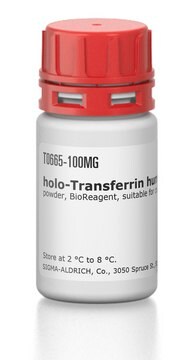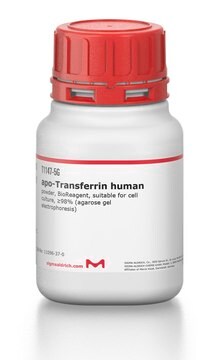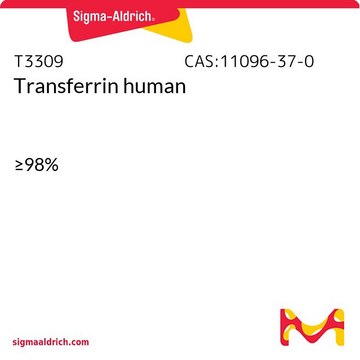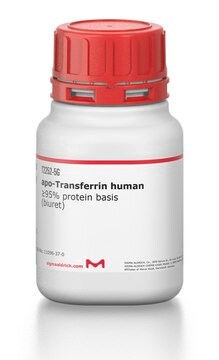T4132
Holo-transferrina human
≥98%
Sinónimos:
Siderofilina, saturada de hierro
About This Item
Productos recomendados
biological source
human
Quality Level
assay
≥98%
form
powder
Iron content
1100-1600 μg/g
technique(s)
cell culture | mammalian: suitable
impurities
HIV, hepatitis B and hepatitis C, none detected
UniProt accession no.
storage temp.
2-8°C
Gene Information
human ... TF(7018)
¿Está buscando productos similares? Visita Guía de comparación de productos
General description
Application
- in colony-forming assays
- for transferrin uptake and recycling in transfected HEK-293 (human embryonic kidney) cells or bone marrow cells
- for the preparation of luteinizing and non- luteinizing granulose cells
Biochem/physiol Actions
Analysis Note
Disclaimer
Storage Class
11 - Combustible Solids
wgk_germany
WGK 3
Certificados de análisis (COA)
Busque Certificados de análisis (COA) introduciendo el número de lote del producto. Los números de lote se encuentran en la etiqueta del producto después de las palabras «Lot» o «Batch»
¿Ya tiene este producto?
Encuentre la documentación para los productos que ha comprado recientemente en la Biblioteca de documentos.
Los clientes también vieron
Protocolos
Separation of HPLC protein standard mixture, analytical standard
Nuestro equipo de científicos tiene experiencia en todas las áreas de investigación: Ciencias de la vida, Ciencia de los materiales, Síntesis química, Cromatografía, Analítica y muchas otras.
Póngase en contacto con el Servicio técnico












